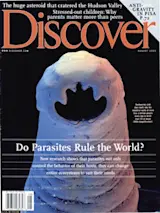Photography by Polly Borland
Rupert Sheldrake gazes, rapt, at the TV monitor. The videotape he is showing as part of a public lecture at Cambridge University portends, in his view, nothing less than the shattering of modern biology. It also features a cute dog. The tape, produced by an Austrian television station, looks more like a low-budget domestic farce than a paradigm smasher. On the right side of the split screen, the dog's owner, a woman named Pam Smart, is shown gadding about the English village of Ramsbottom. On the left side, her terrier-cross, Jaytee, who has remained at home, lies curled up at the feet of Pam's mother, Muriel. Beneath each of these slow-moving dramas, synchronized videotape counters tick by, confirming that the camera locked on Jaytee and the camera tracking Pam show simultaneous activity. Suddenly, a researcher accompanying Pam tells her it's time to leave. Eleven seconds later, ...














